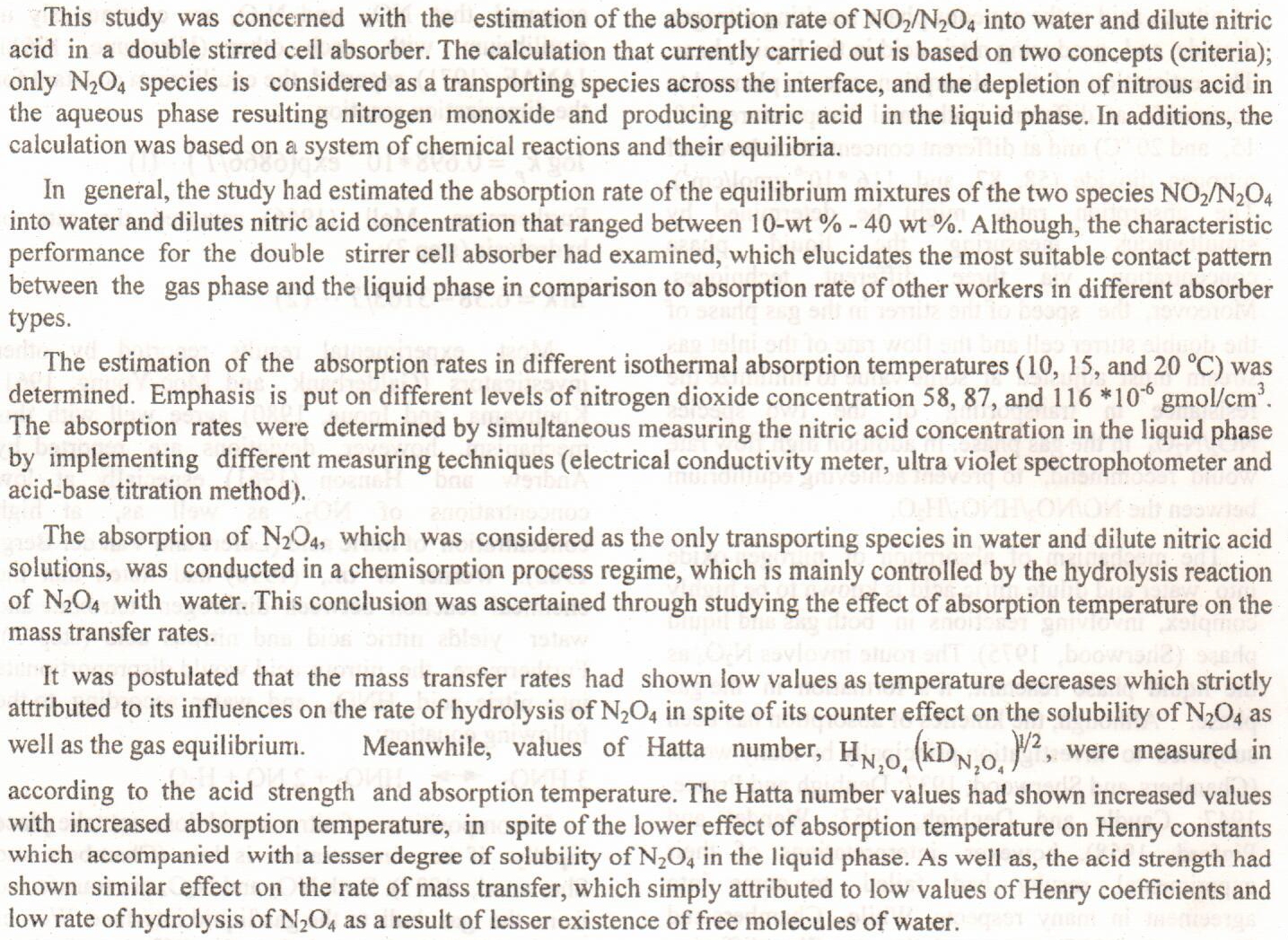
In the present study, the removal of zinc from synthetic waste water using emulsion liquid membrane extraction technique was investigated. Synthetic surfactant solution is used as the emulsifying agent. Diphenylthiocarbazon (ditizone) was used as the extracting agent dissolved in carbon tetrachloride as the organic solvent and sulfuric acid is used as the stripping agent. The parameters that influence the extraction percentage of Zn+2 were studied. These are the ratio of volume of organic solvent to volume of aqueous feed (0.5-4), ratio of volume of surfactant solution to volume of aqueous feed (0.2-1.6), pH of the aqueous feed solution (5-10), mixing intensity (100-1000) rpm, concentration of extracting agent (20-400) ppm, surfactant co
... Show MoreSediment samples were collected from main water processing and supply plants in Baghdad, and tested for radioactivity from both natural and artificial sources. These stations are: East Dijla (Tigris), Al-Kadisia, Al-Karama, Al-Rasheed, Al-Sader, Al-Wathba, and Al-Wihda supply stations. Qualitative measurements were made, and the results showed that most sediments exhibited natural radioactive level and sometimes less than the international regular standards. Specially, K-40 and Ra-226 results were much less than the standards for radioactive concentrations. Ac-228 concentration was found rather than Th-232 (in Al-Sader and Al-Wihda samples) but with low concentrations of about 10-15 Bg/kg and detection confidence ~45% , and Ce-141 and Be
... Show MoreThis study aimed to study the effect of Ziziphus spina christi Aqueous cold and Alcoholic leaves and fruits extracts on the growth and activities of the following types of bacteria :( Escherichia coli, Pseudomonas aeruginosa, Staphylococcus aureus and Streptococcus pyogenes ). The results appeared outweigh the alcoholic extract of leaves and fruits of Sidr that prepared by saxholate extractor by addition of ethanol 95% significant superiority as compared with aqueous extract that prepared by using distilled water as was its influence inhibitor to the growth and effectiveness of bacteria , about the treatment of in-vivo to cause injury to these types of bacteria diagnosed laboratory mice and treated with alcoholic extract of the leaves o
... Show MoreBackground: Temporomandibular joint disorders refer to a group of heterogeneous pain and dysfunction conditions involving the masticatory system, reducing life quality of the sufferers. Arthrocentesis is simple and less invasive surgical procedure for the treatment of internal derangement than arthroscopy and better than other conservative procedures such as drugs, occlusal appliances and physiotherapy. The aim of the study was to evaluate the effect of arthrocentesis with injection of hyaluronic acid in the treatment of internal derangement of temporomandibular joint for the restoration of its function, reducing pain and preventing further deterioration of the temporomandibular joint dysfunction. Materials and methods: This study was perfo
... Show MoreABSTRACT : A new ligand [ 2- (3-acetylthioureido)-3-phenylpropanoic acid (APA) is synthesized by reaction of acetyl isothiocyanate with phenylalanine (1:1). It is characterized by micro elemental analysis (C.H.N.S.), FT-IR, (UV-Vis) and 1H and 13CNMR spectra. Some metals ions complexes of this ligand were prepared and characterized by FT-IR, UV-Visible spectra, conductivity measurements, magnetic susceptibility and atomic absorption. From results obtained, the following formula [M(APA)2] where M2+ = Mn, Co, Ni, Cu, Zn, Cd and Hg, the proposed molecular structure for these complexes as tetrahedral geometry, except copper complex is has square planer geometry.
New schiff bases series (VIII) a-e and 1,3-thiazolidin-4-one derivatives (IX) a-e containing the 1,2,4-triazole and 1,3,4-thiazazole rings were synthesized and screening their biological activities. These compounds were identified via Fourier transform infrared (FT-IR) spectra, some via Proton nuclear magnetic resonance (1H-NMR) and mass spectra. The biological results indicated that all of these compounds did not reveal antibacterial effectiveness against (Escherichia coli and Klebsiella species) (G-). Some of these compounds showed moderate antibacterial activity against (Staphylococcus aureus, and Staphylococcus epidermidis) (G+), and all compounds exhibited moderate activity against Candida albicans.
 (1)
(1)
Objective: Conventional approaches for disinfection, including spraying and immersion, resulted in only surface disinfection of impressions. As a result, self-disinfecting impression materials incorporated with antimicrobial compounds require more extensive studies. The incorporation of a disinfectant into irreversible hydrocolloid impression materials could eliminate the need for the disinfection step by conventional approaches, including spraying and immersion which only result in surface disinfection of impressions. The study was aimed to investigate the effect of incorporation of hypochlorous acid in irreversible hydrocolloid materials on antimicrobial efficiency, detail reproduction, and dimensional stability. Materials and
... Show More (15)
(15)
 (3)
(3)
